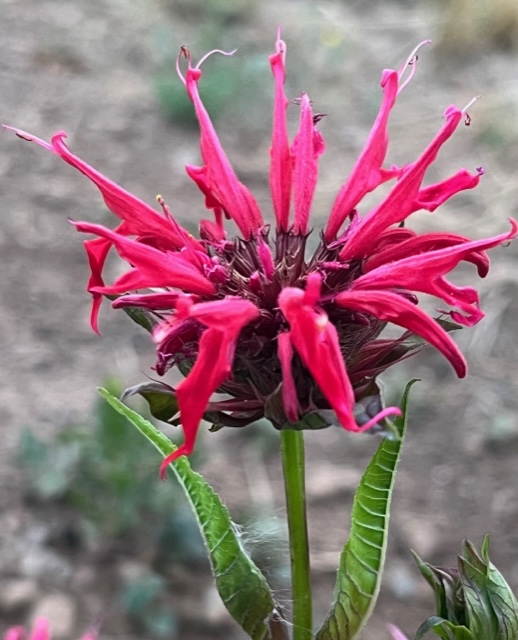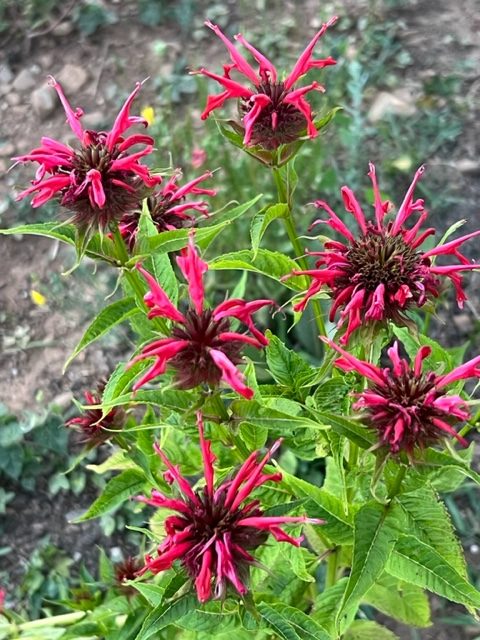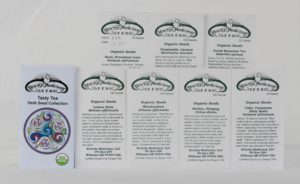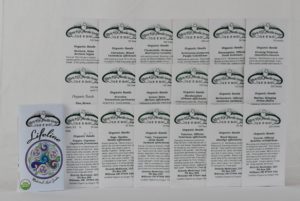Bergamot, Red (Oswego Tea) (Monarda didyma) packet of 20 seeds, organic
$4.95
Family: Mint (Lamiaceae)
Hardy to Zones 4 to 9
(Oswego Tea, Crimson Beebalm, Scarlet Beebalm) Herbaceous perennial native to Eastern North America, Flowering crimson to 3 feet. One of our better native American tea plants, the aroma and taste is similar to bergamot orange (Citrus bergamia) of Earl Grey Tea fame. Traditional uses (TNAM): Antiseptic, carminative, mood enhancing. Plant prefers sun to part shade and moist, rich soils of garden or edge of woodland. Sow seed in warm conditions by barely covering, tamping well, and keeping evenly moist until germination, which is rapid. Thin or transplant to 2 feet apart.
20 seeds per packet, Certified Organically Grown
In stock







Question
Willow Whyte Lynch –
Is this Bergamot didyma prolific (aka “invasive” in other people’s words)?
Upvote if this was helpful (0) Downvote if this was not helpful (0) Watch Unwatch Flag for removal
Richo Cech –
we wish
Upvote if this was helpful (2) Downvote if this was not helpful (0) Flag for removal
DaLove –
We are in north Georgia, Buford 7b… we have heavy clay, but along our “forest” edge, I’ve amended with leaves and sticks we’ve collected over the past year. I was considering adding another layer of clay to germinate these in, with the leaves and sticks underneath, creating a lasagna effect. Do you think these seeds will germinate in the clay?
Upvote if this was helpful (0) Downvote if this was not helpful (0) Flag for removal
Richo Cech –
hello DaLove, maybe. i would opt for a more standard propagation approach, planting the seeds in a deep flat of potting soil, for more control, and working up to reasonable size before transplanting to forest edge. richo
Upvote if this was helpful (0) Downvote if this was not helpful (0) Flag for removal
Roby Gobeil (verified owner) –
Hi Richo,
It’s been a couple years I have my monarda didyma patch but in the autumn, when the heads dries out, I try to collect the seeds but I NEVER have seeds. Sometimes a couple but empty ones.
Do I need more individuals for a genetic diversity or it is more a question of pollinators or temperatures? DO the pollination depend on hummingbirds or other specifics pollinators?
Thanks for your help!
Upvote if this was helpful (0) Downvote if this was not helpful (0) Flag for removal
Richo Cech –
Hi Roby, Good observation. These tend to be low producers. They tend to make a lot of duds (tiny hard dots that remain unpollinated and never mature into seeds). Also, they have a wide and long seed tube in comparison to the other species, making it easier for birds to access whatever mature seeds might have formed properly, and also more likely that seed will disseminate as the wind bends the plant. One thing I’ve observed is that rampant spreaders like this (rhizomatous) are less likely to produce much seed. It is a kind of balance, or conservation of reproductive energy, that occurs in many species–fast-growing rhizomes=poor seed production, clumping habit=prolific seed production. There are of course exceptions to this rule… The flowers of red bergamot are hermaphroditic and require long-tongued pollinators such as butterflies and hummingbirds to pollinate. Yes, a large population composed of individuals with different parentage (seed-grown) is crucial. Our seed count per packet and price per packet reflect the difficulty of generating seed resources for this species. Funny, I was just thinking of one lady who complained of zero germ on these and I sent her cuttings from my plants and she never acknowledged the effort and expense. . . You’ll enjoy the bergamot section in my new book “Growing Plant Medicine Vol 2” coming out soon. Keep growing. Richo
Upvote if this was helpful (1) Downvote if this was not helpful (0) Flag for removal
Roby Gobeil (verified owner) –
Hi Richo, really appreciate the explanations!
This year 2023, we also get a lot of rain, I mean a LOT! We sometimes get 1-2 days without rains, the rest was floody and constantly humid. The quality and the amount of successful pollinations get heavily affected. Our approach will be to install a big population of Monarda Didyma, which I love so much, and then wish to have enough hummingbirds (which we already have), and butterflies to visit those great flowers.
Thanks again for your sharing and your precious seeds, I’ll stay tuned for your new book, I already have the Vol 1 and it helped me a lot through my gardening path.
Great day!
Roby
Upvote if this was helpful (0) Downvote if this was not helpful (0) Flag for removal